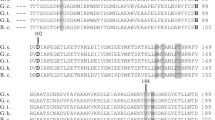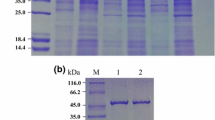Abstract
A series of site-directed mutant glucose isomerase at tryptophan 139 from Thermoanaerobacterium saccharolyticum strain B6A were purified to gel electrophoretic homogeneity, and the biochemical properties were determined. W139F mutation is the most efficient mutant derivative with a tenfold increase in its catalytic efficiency toward glucose compared with the native GI. With a maximal activity at 80 °C of 59.58 U/mg on glucose, this mutant derivative is the most active type ever reported. The enzyme activity was maximal at 90 °C and like other glucose isomerase, this mutant enzyme required Co2+ or Mg2+ for enzyme activity and thermal stability (stable for 20 h at 80 °C in the absence of substrate). Its optimum pH was around 7.0, and it had 86 % of its maximum activity at pH 6.0 incubated for 12 h at 60 °C. This enzyme was determined as thermostable and weak-acid stable. These findings indicated that the mutant GI W139F from T. saccharolyticum strain B6A is appropriate for use as a potential candidate for high-fructose corn syrup producing enzyme.





Similar content being viewed by others
References
Amore R, Hollenberg C (1989) Xylose isomerase from Adinoplanes missouriensis: primary structure of the gene and the protein. Nucleic Acids Res 17(18):7515. doi:10.1093/nar/17.18.7515
Antrim RL, Colilla W, Schnyder BJ (1979) Glucose isomerase production of high-fructose syrups. Applied biochemistry and bioengineering. Academic Press, London. doi:10.1016/B978-0-12-041102-3.50010-9
Bandlish RK, Michael Hess J, Epting KL, Vieille C, Kelly RM (2002) Glucose-to-fructose conversion at high temperatures with xylose (glucose) isomerases from Streptomyces murinus and two hyperthermophilic Thermotoga species. Biotechnol Bioeng 80(2):185–194. doi:10.1002/bit.10362
Bhosale SH, Rao MB, Deshpande VV (1996) Molecular and industrial aspects of glucose isomerase. Microbiol Rev 60(2):280–300
Bor Y-C, Moraes C, Lee S-P, Crosby WL, Sinskey AJ, Batt CA (1992) Cloning and sequencing the Lactobacillus brevis gene encoding xylose isomerase. Gene 114(1):127–132. doi:10.1016/0378-1119(92)90718-5
Borgi MA, Rhimi M, Bejar S (2007) Involvement of alanine 103 residue in kinetic and physicochemical properties of glucose isomerases from Streptomyces species. Biotechnol J 2(2):254–259. doi:10.1002/biot.200600085
Borgi MA, Srih-Belguith K, Ben Ali M, Mezghani M, Tranier S, Haser R, Bejar S (2004) Glucose isomerase of the Streptomyces sp. SK strain: purification, sequence analysis and implication of alanine 103 residue in the enzyme thermostability and acidotolerance. Biochimie 86 (8):561–568. doi:10.1016/j.biochi.2004.07.003
Brown SH, Sjøholm C, Kelly RM (1993) Purification and characterization of a highly thermostable glucose isomerase produced by the extremely thermophilic eubacterium, Thermotoga maritima. Biotechnol Bioeng 41(9):878–886. doi:10.1002/bit.260410907
Cha J, Batt C (1998) Lowering the pH optimum of d-xylose isomerase: the effect of mutations of the negatively charged residues. Mol Cells 8(4):374
Converti A, Borghi MD (1997) Kinetics of glucose isomerization to fructose by immobilized glucose isomerase in the presence of substrate protection. Bioprocess Eng 18(1):27–33. doi:10.1007/s004490050406
Dekker K, Yamagata H, Sakaguchi K, Udaka S (1991) Xylose (glucose) isomerase gene from the thermophile Clostridium thermohydrosulfuricum; cloning, sequencing, and expression in Escherichia coli. Agric Biol Chem 55(1):221–227. doi:10.1271/bbb1961.55.221
Dische Z, Borenfreund E (1951) A new spectrophotometric method for the detection and determination of keto sugars and trioses. J Biol Chem 192(2):583–587
Hespell RB (1992) Fermentation of xylans by Butyrivibrio fibrisolvens and Thermoanaerobacter strain B6A: utilization of uronic acids and xylanolytic activites. Curr Microbiol 25(4):189–195
Jeltsch A, Lanio T (2002) Site-directed mutagenesis by polymerase chain reaction, vol 182. In vitro mutagenesis protocols. Humana Press, New York. doi:10.1385/1-59259-194-9:085
Jensen VJ, Rugh S (1987) Industrial-scale production and application of immobilized glucose isomerase. Methods Enzymol 136:356–370. doi:10.1016/S0076-6879(87)36035-5
Lama L, Nicolaus B, Calandrelli V, Romano I, Basile R, Gambacorta A (2001) Purification and characterization of thermostable xylose (glucose) isomerase from Bacillus thermoantarcticus. J Ind Microbiol Biotechnol 27(4):234–240. doi:10.1038/sj.jim.7000182
Lee CY, Zeikus JG (1991) Purification and characterization of thermostable glucose isomerase from Clostridium thermosulfurogenes and Thermoanaerobacter strain B6A. Biochem J 273(Pt 3):565–571
Lee Y-E, Ramesh MV, Zeikus JG (1993) Cloning, sequencing and biochemical characterization of xylose isomerase from Thermoanaerobacterium saccharolyticum strain B6A-RI. J Gen Microbiol 139(6):1227–1234. doi:10.1099/00221287-139-6-1227
Meaden PG, Aduse-Opoku J, Reizer J, Reizer A, Lanceman YA, Martin MF, Mitchell WJ (1994) The xylose isomerase-encoding gene (xylA) of Clostridium thermosaccharolyticum: cloning, sequencing and phylogeny of Xy1A enzymes. Gene 141(1):97–101. doi:10.1016/0378-1119(94)90134-1
Meng M, Lee C, Bagdasarian M, Zeikus JG (1991) Switching substrate preference of thermophilic xylose isomerase from d-xylose to d-glucose by redesigning the substrate binding pocket. Proc Natl Acad Sci USA 88(9):4015–4019. doi:10.1073/pnas.88.9.4015
Mu W, Wang X, Xue Q, Jiang B, Zhang T, Miao M (2012) Characterization of a thermostable glucose isomerase with an acidic pH optimum from Acidothermus cellulolyticus. Food Res Int 47(2):364–367. doi:10.1016/j.foodres.2011.09.006
Privalov PL (1990) Cold denaturation of proteins. Crit Rev Biochem Mol Biol 25(4):281–305. doi:10.3109/10409239009090613
Srih-Belghith K, Bejar S (1998) A thermostable glucose isomerase having a relatively low optimum pH: study of activity and molecular cloning of the corresponding gene. Biotechnol Lett 20(6):553–556. doi:10.1023/A:1005393510435
Author information
Authors and Affiliations
Corresponding author
Additional information
H. Xu and D. Shen equally contributed to this study.
Rights and permissions
About this article
Cite this article
Xu, H., Shen, D., Wu, XQ. et al. Characterization of a mutant glucose isomerase from Thermoanaerobacterium saccharolyticum . J Ind Microbiol Biotechnol 41, 1581–1589 (2014). https://doi.org/10.1007/s10295-014-1478-4
Received:
Accepted:
Published:
Issue Date:
DOI: https://doi.org/10.1007/s10295-014-1478-4




